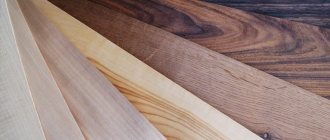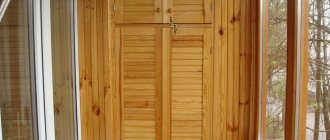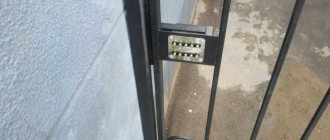Miscellaneous
The decorative covering of a door deteriorates over time and loses its attractiveness. If the old paint is cracked and peeling in places, it is recommended to remove the old coating before applying a new coat. But it also happens that the surface has only lost its shine, has become dull, or spots have appeared on it, but the layer itself lies smoothly and has retained its integrity. In such cases, there is no point in carrying out work to remove the old coating. It will not be possible to qualitatively remove the old layer of paint that has retained its strength. It is difficult to remove. As a result, you can only damage the doors or get a surface whose quality is much lower than the original version.
Color selection
When choosing a color for painting doors, you need to focus on the color scheme in the room. The shade should be combined with furniture, walls and floors.
Recommendations for choosing colors:
- for a strict classic interior, the colors of dark and light wood species are suitable;
- for a minimalist style - cool light shades;
- Doors painted with glossy paints of different colors combine with modern style;
- in the high-tech style, doors can be painted in any bright or metallic color;
- The white color of the door will be combined with different interior styles. A light canvas helps to visually enlarge the room;
- the shade of the door should be average between the color of the interior and the floor covering;
- dark furniture is combined with a door several shades lighter;
- each side of the door can be painted in different shades if the color scheme in the rooms is very different;
- It is better to paint solid wood doors with clear varnish. It will emphasize the natural beauty of the wood pattern;
- in a children's room, the canvas can be painted in bright shades or combined several colors;
- Soft light colored doors are suitable for the bedroom.
Interior doors will look beautiful if they are painted cream, pale pink, or light green. Their shade can be emphasized with the help of accessories: curtains, sofa cushions, curtains.
Options for combining the colors of the door, baseboard and floor
Color solutions for room decoration play an important role in creating comfort. To feel more comfortable in your own home, you need to create harmony in it. Some people understand this as a combination of colors in the final arrangement of rooms, i.e. they pay more attention to the combination of furniture, curtains, all kinds of accessories, etc.
In this case, of course, their harmonious fusion with walls, floors and ceilings is taken into account. But this is not where you should start. Complete harmony can be achieved if you think about the color combination between the main elements of the premises at the preparatory stage.
But we must not forget about such things as doors, trim, baseboards - these are integral parts of the interior of each room, and should not fall out of the overall image. Therefore, the combination of colors of doors, baseboards and floors must be given no less attention. The owner of the apartment should feel comfort at an intermediate stage - after the completion of the renovation, but even before the start of arrangement of the premises (i.e. in the absence of furniture, curtains, carpets, etc.).
In general, color matching is a big science, but it’s not difficult to master. Especially if you remember that there are 7 primary colors in nature - a “rainbow of colors”. Everything else is their shades and combinations.
Someone might say that there are 2 more basic colors - white and black. But, oddly enough, they also have to do with the combination of 7 colors. A rainbow is the spectral decomposition of white into its components (from red to violet). And black color is the opposite of white (“a black hole”, for example, is a vacuum, i.e. emptiness).
Door materials and paint choice
The range of paints is varied, so when choosing, you need to take into account the color, composition and characteristics of the coloring agent. Depending on the door material, the surface is painted with paints of different compositions. The following types of paints exist:
- Acrylic. To update the color of the door, water-based paint is suitable. Its main advantages: lack of odor, fast drying and good adhesion to the surface. The canvas can be painted in several layers. To protect the surface from damage, it is recommended to apply varnish on top. Acrylic is suitable for painting doors made of the following materials: metal, wood, MDF. Products made from fiberboard are rarely painted with this type, since the paint does not hide surface roughness well.
- Alkyd. Enamel forms a film on the surface of the door that is resistant to moisture and mechanical damage. Alkyd enamels are made in a variety of colors and shades. The disadvantage of paint is a strong odor that dissipates within two to three days. Surfaces made of any material can be painted.
- Polyurethane. Paints are resistant to high humidity, temperature changes and chemicals. When painting, an unpleasant odor is released, which disappears after it dries and the room is ventilated. Polyurethane paint is best for painting doors in bathrooms, saunas, baths. It fits well on any material.
- Nitro paints. An inexpensive type of dye that is harmful if inhaled. Dries within a few hours. The painted coating is moisture-resistant and resistant to mechanical damage. This paint can be used to paint metal and wooden doors.
- Oily. The type of coating will last up to five years. After painting, a film forms on the canvas, which prevents the material from breathing. The disadvantages of enamel are long drying time and a strong odor. Suitable for metal doors.
- Hammer and powder. Types of paints are used only for painting metal doors.
- Lucky. The material can be used as a stand-alone product or to secure a painted surface with paint. Use clear and tinted varnishes. The first emphasize the texture of painted canvas made of different materials. The second ones add shade and shine to wooden doors.
For painting wooden interior doors, MDF and chipboard, it is recommended to use paints that have an average level of durability and no strong odor.
Which paint to choose
First, decide what paints are used to apply to the door:
- Alkyd enamels. This is the most affordable option. Film strength is average. The advantages include a large range of colors and compatibility with MDF, fiberboard and wood. The main disadvantage is the long drying time and the characteristic pungent odor. Among materials of this type there are a large number of glossy coatings.
- Acrylic enamels. This type of paint is a water dispersion of acrylates. The main advantage over other compositions is the absence of odor and quick drying. In addition, the color palette, represented by hundreds of colors, allows you to create unique shades yourself. To protect the surface, it is additionally coated with parquet transparent varnish.
- Oil-based tinting paints are great for transforming interior and entrance doors. Absorbing into the wood texture they give it a unique shade. The only condition for their use is wood, without any coating.
Variety of paints and varnishes
- Nitro enamels. They dry quickly, but at the same time the volatile, caustic solvent evaporates, which can cause poor health and even poisoning. If you take precautions and use personal protective equipment when working, then this option deserves attention. After the solvent has completely evaporated, the coating becomes safe. It is considered a high-quality and fast method of painting.
- Colored varnishes, glazes. These materials are used for painting varnished door panels. Used in cases where there are no significant cracks or chips on the base. To fully restore the varnished surface, the old varnish must be removed, or you can refuse to re-varnish and paint over the interior doors after puttying.
Required Tools
After choosing the color and paint, you need to purchase tools. These include materials that will be needed to prepare the door for painting and directly for the painting procedure.
Necessary tools for work:
- wide brushes;
- thin brushes for hard-to-reach places;
- rollers with a pile of at least 5 mm;
- paint cuvette;
- rubber and metal spatula;
- screwdriver;
- sanding machine or sandpaper;
- construction hair dryer or blowtorch;
- masking tape.
When working with new and old canvas, it is necessary to follow the correct sequence of actions and painting technology.
Useful tips for beginners
For ease of work and control over dipping the tool into paint, use a paint tray.
After purchasing the brushes, it is recommended to comb them out a little and soak them in water for a while. Firstly, this will prevent fallen hairs from reaching the surface, and secondly, it will soften the stubble before work.
It is more convenient to paint the canvas if it is located in a horizontal position. This way you won’t get unsightly streaks if there is too much paint in the corners and sides of the door leaf. Many people use specially prepared sawhorses for convenience, or take the easier route and place the door on 4 stools.
Protection of fittings from smudging. This is not a whim, but a reasonable step. It is advisable to twist it and put it aside for the duration of the work, but an option to protect it is also suitable, for which it is recommended to use masking tape.
Drips resulting from painting can be easily removed if you use a sponge, and then hide its traces by going over the area with a roller.
While the painted canvas is drying, make sure that no accidental dust gets on it or that a stray midge does not stick to it. To do this, it is better to do coloring in a special workshop.
Video on how to properly paint entrance blocks in a house or apartment:
You can update interior or entrance doors in different ways. Painting without removing the old layer is the easiest and fastest method, which home craftsmen most often resort to. The result of the work: a beautiful door without much effort!
Voted over 169 times, average rating 4.6
Comments
Ira 01/30/202015:56 It’s better not to paint interior doors. the paint will stink for a long time
Grade
Add a comment Cancel reply
We recommend reading
Miscellaneous Interesting glass decoupage technique, DIY door decoration Do you want to update the decor of your favorite room, but don’t want to start again...
Miscellaneous Recommendations from professionals on choosing a door frame for interior doors To install a door, you will need to choose the right door…
Miscellaneous Main distinctive characteristics of moldings for interior doors Manufacturers offer door designs of standard sizes, ...
Miscellaneous What is the purpose of installing brushes on interior doors? To make using the interior door convenient and not separate...
New canvas painting technology
The new canvas can be treated in two ways: paint or varnish (stain).
To properly paint a door with your own hands, perform the following steps:
- The canvas must be placed vertically on a prepared surface or some kind of stand.
- Treat the door with sandpaper or a grinding machine to remove factory roughness and burrs.
- Wipe products made from pine with acetone to remove resin.
- Treat the surface on both sides with a primer: first the recesses, then the remaining parts. After the product has been absorbed, apply a second layer.
- Pour the paint into the ditch and start painting the door. Paint the corners of the door with a brush, starting from the top. Smooth surfaces can be painted with a roller, with depressions and recesses - with a brush.
- Distribute the paint evenly without streaking. It should not be thick, so watch the consistency.
- Depending on the type of paint, apply two to four layers. Paint each new layer after the previous one has dried.
- Paint the door opening.
- Treat the surface with varnish - one or two layers. On a door that is treated only with varnish, it is necessary to apply at least three to seven layers.
Using stain, you can emphasize the texture of wood and change its shade. Apply it to the prepared canvas with a brush. Treat the surface with varnish or wax after the stain layer has dried.
How to paint a lacquered door white
It would seem that what could be simpler than painting a door? A flat surface that you just want to roll a roller over. The child seems to be able to cope. What if the canvas is covered with dark varnish? What if a layer of epoxy resin is applied on top?
The door can also be figured or made of wood-based materials of dubious quality. And I want the perfect white color.
So why give up your dream? Of course, there is no need to give up anything. People fly into space, and then there is a door. Of course, you will have to tinker not only with the roller.
How to remove old paint?
When painting a door that has already been in use, it is necessary to prepare its surface for the work. To distribute the paint evenly, it is important that the surface is cleaned of old paint and sanded.
Instructions on how to remove old paint:
- The door is removed from its hinges and laid on a flat surface. If it is impossible to remove it, seal the hinges with tape or masking tape. Remove fittings: handles, locks.
- Using a hair dryer, heat a layer of old paint, which will come off well from the surface. For the procedure, you can use a blowtorch.
- Use a spatula to clean the paint.
- Sand the cleaned surface to remove roughness and small paint residues.
- Cleaning the door of peeling paint is not difficult. In this case, it is enough to treat the surface of the canvas with a spatula and sandpaper.
- There is another way to remove old paint. For this, a special remover is used, which, due to its chemical composition, will corrode the layer of dye. You can purchase it at any hardware store. For the job you will also need a spatula and a sanding machine.
- The final stage: cleaning the surface from dust and applying white spirit or primer.
When cleaning the surface of a wooden door with a blowtorch, you must act carefully; there is a risk of burning through the door.
Features of painting over an old layer
At first glance, painting a wooden door over an old layer seems like a trivial matter: just go ahead and paint it.
Painting the door
But in fact, in order to paint a wooden door and get a surface that will be no worse in quality than factory painting, learn a few rules:
- The surface of the door, regardless of its condition, must be carefully prepared. Against the background of the old paint, cracks and potholes are invisible, but after applying a new layer they will appear and ruin all your efforts.
- The right choice of material for painting an interior door. It’s not just a matter of proper selection of color, surface texture or the strength of the film formed. It is important to consider the compatibility of materials. Many paints are not compatible with each other, and if chosen incorrectly, the old coating may curl or bulge when it comes into contact with the new material.
- Decide on the correct paint application technique. For doors with a complex structure, it is possible to obtain a smooth and neat surface with proper selection and combination of painting techniques and painting tools.
The last rule, common to all cases of working with paint, is to strictly follow the instructions for applying the selected paint material.
How to quickly putty?
The surface of the door is puttied if cracks, chips and other defects (pits from knots, etc.) appear on it. With the help of the material, the surface will acquire a smooth and even appearance. You can process the door completely or only certain places.
To complete the work you will need:
- putty;
- putty knife;
- sandpaper.
The puttying procedure is quick and simple:
- clean the sanded surface of the door and prime it;
- mix the putty until the structure is homogeneous;
- Use a spatula to take a small amount of material. Place it slightly above the defective area and move it down, carefully remove the excess;
- If there is a deep crack, do not fill it at once. Apply the putty in two approaches, the second layer after the first has dried;
- Treat the surface of the door with sandpaper after the material has completely dried.
For wooden surfaces, use acrylic or water-based putties.
Selecting the type of coloring composition
All paints can be divided into transparent and pigmenting compositions. The first include varnishes, which are more suitable if wooden doors do not have serious defects and they are simply planned to be refreshed without changing color. But, since these interior elements are functional structures that are in constant use, due to this, noticeable chips, cracks and other flaws very often appear on them, spoiling the appearance.
Therefore, often for high-quality restoration of a door leaf, a simple coating of varnish is not enough. For these purposes, it is advisable to use pigmenting paints that can mask and eliminate more serious defects.
In addition to color, paints also differ in their composition. The choice of their type according to this parameter will directly depend on what the interior doors are made of. By paying attention to the table below, you can understand in which cases it is better to use one or another type of coating composition.
| Material of which the interior door is made | Recommended paint type |
| Array | Completely wooden products can be painted with almost any paint. For example, all oil-based products and alkyd enamel have worked well in this case. These materials come in a wide range of colors and, once dry, form a durable, durable coating. They have practically no drawbacks, except for the strong smell that is felt in the room for 3-4 days after painting the canvases. When you do a DIY restoration of interior doors in a house where there are children, it is, of course, better to use acrylic enamel. It is odorless, non-toxic, and dries quickly. But its main drawback is its fragile and short-lived surface. |
| MDF | It is advisable to paint MDF doors with compositions that simultaneously include tone and varnish (colored varnishes). Such paints help to preserve the texture of the material on such canvases and mask any existing defects. |
| Veneer | It is highly not recommended to use nitro paints for veneered interior doors, since this composite material does not tolerate moisture. After applying such compositions, unsightly stains may form on them. It is better to paint veneer doors with polyurethane or glypthal compounds. They do not have a strong odor, so it is comfortable to work with them. As for the choice of color, according to this parameter they can be selected to suit every taste. |
| According to inherent characteristics | Anti-corrosion, moisture-resistant, heat-protective, antiseptic. |
| By place of application | Universal or separately for external and internal work. |
See our detailed review of odorless wood paints.
Whatever paint is chosen, in any case it should be intended for interior work. Moreover, if there is strong moisture in the room where the interior door is located (kitchen, bathroom), then the compositions are certainly selected with moisture-resistant properties.
Coloring with two colors
The door can be painted in two or more colors, combining different shades. This coloring is especially relevant for children's rooms when creating bright multi-colored doors.
To carry out the work, you will need a standard set of tools, as with regular painting.
Features of painting in two colors:
- To separate the border between shades, you need to stick masking tape or tape. Carefully run a spatula or other hard object over the tape so that no air bubbles remain underneath. If the fit is not tight, the paint may flow to the opposite side. Remove the tape while the paint is still wet, otherwise you may damage the painted edges.
- After painting one side, you need to wait for it to dry completely, after which the tape is glued to the opposite side and you can start painting the second side.
When painting a door with a glass insert, it is necessary to stick adhesive tape or masking tape on it to protect it from paint drops.
Painting technologies
When painting a door, you can use either a brush or a roller. The brush may leave drips and streaks. Therefore, before work, fluff it thoroughly to get rid of loose and loose hairs, and while painting, move the brush along and across the surface to smooth out unevenness.
If you use a roller, roll out the paint properly so that it lays in a thin layer. Do not press the roller too hard during the process, and roll it over the surface with light, even movements.
The surface of the door will not be painted evenly the first time; the wood will absorb most of the paint. Re-painting will be required, and perhaps more than one.
It is very important to first clean the white door from dirt and dust.
This method is great if you want to paint your door white. The main thing is to clean the surface with special care so that there is no dirt or dust left on it.
Simple door leaf
This is the simplest job, so we'll look at it first. However, you need to be careful not to leave noticeable stains or smudges on the door.
For such work, you can purchase a special sprayer: it will greatly facilitate the process. But for painting one or two doors, purchasing such a device will not be financially feasible. Therefore, you can easily get by with a roller and a filing brush.
The painting scheme depends on the type of door structure.
- The panel door is painted in 3 steps. The easiest way is to use a roller for this: it will apply the paint evenly and will not leave hairs. Start covering from the upper left corner of the door, moving to the right. When the canvas is finished painting, leave it to dry for as long as the instructions for the coloring agent require. The second stage of painting is carried out in the longitudinal direction, the third - in the opposite direction from the first step.
- For a paneled door, it is better to use a brush. Walk it along the recesses in the canvas, while trying to avoid excess paint. Finish painting with a roller, using the diagram for the panel door.
Painting with stain
If you decide to stain your door, prepare it and lightly dampen it. This way, moisture will not be absorbed into the wood, and the dye will lie evenly, despite its liquid consistency. Paint everything that is horizontal first along the grain, then across it, and at the end of the work again in the longitudinal direction.
If you decide to paint the door in a vertical position and have not removed it from its hinges, start covering the jambs and door leaf from the bottom so that splashes do not fall on the unpainted surface. This is especially important if you plan to varnish the door.
The wood fibers straighten out by absorbing the water-soluble stain. After the first layer has dried, sand the surface with sandpaper, clean and re-stain.
After drying, the wooden surface will become lighter than when applying the stain. To make the color more vibrant, apply the dye several times.
Alcohol stain does not straighten wood fibers, so you won't have to sand the door after applying it. In addition, it dries in half an hour. But water-soluble stain is more popular because it is considered safer and non-toxic.
Wood imitation
This method is applicable on any surface. As for wood, on old doors that have been subject to deep restoration, it may also be necessary to apply a pattern that is as close as possible to a pronounced natural one.
- Cover the canvas with yellow, light beige or light gray paint. Dry according to the instructions for the coloring agent.
- Apply liquid soap to the surface to be treated using a brush.
- Apply a coat of your chosen dark paint and rinse off with liquid soap.
Recommendations for applying a pattern imitating wood
There is another way to imitate a wood pattern on a door. To do this, you need a special brush, which you can buy at a hardware store. Soft wood fibers are processed with such a brush using movements similar to combing. Thanks to changes in the structure, curls will spontaneously appear, creating the illusion of wood. After the surface has dried, it needs to be sanded.
Aging of doors
By painting you can get the effect of an “aged” door. Interior doors with a patina effect are especially popular. To create an antique canvas, products made from wood, MDF and chipboard are suitable.
Instructions for patination:
- The surface of the canvas is brushed with a wire brush to give it a rough texture.
- Apply the first coat of paint using a spray gun to avoid smudges. Most often, dark paint or one close in tone to the “native” color of the door is used for the main tone.
- After the painted layer has dried, the surface is primed.
- The next layer is a gray patina.
- The surface is rubbed using sandpaper, paying special attention to individual areas. The worse the wear, the older the door looks.
- Apply varnish to the surface - two to three layers.
For the main color when creating an aged door, you can use gold, silver, and black enamels.
An antique effect can be given to the door using stain. To do this you need to do the following:
- A water-based stain is applied to the canvas. The shade of the product is darker than what is planned to be obtained as a result of coloring;
- immediately after application, use felt to wipe off areas of stain in places where they plan to create abrasions;
- Apply white spirit-based stain to the dried layer;
- Rub the surface with wax.
Before applying the stain, the canvas can be treated with an iron brush or a plane, in this way you can achieve a greater effect of aging the door.
How will we paint our wooden door?
The choice of compositions for coloring wood is very extensive. First of all, let's decide whether it is desirable to preserve and highlight the natural beauty of a natural array or whether it is necessary to completely hide the texture pattern by covering it with a continuous opaque layer.
Taking into account our own taste preferences, we will pay attention to: opaque enamels and coloring compositions with acrylic, polyurethane, alkyd, perchlorovinyl and obsolete oil bases, which are rarely found in domestic products; transparent and tinted varnishes, oil impregnations, stains that refresh the color of wood or give new shades. We won’t talk about taste priorities.
Let’s just listen to the advice of experienced painters who recommend that home craftsmen buy: water-based acrylic paints, because they have the optimal consistency for working with a brush, excellent spreadability and decent hiding power, somewhat inferior to oil paints; alkyd paint and varnish products, characterized by high water-repellent qualities, resistance to temperature fluctuations and drying speed. Of the recommended options for painting bath doors, the second type, resistant to negative influences, is most suitable. Moreover, it can be used to paint both entrance and interior doors.
Exclusive decor
Painted canvases can be given an original and unique design using exclusive decor. For this you can use:
- Wallpaper. Various types of wallpaper are used for decoration: fabric, vinyl, photo wallpaper and others. With their help, you can highlight individual areas.
- Fabrics: silk, velvet, cambric, voile, etc. Using drapery you can create original designs on the doors.
- Painting horizontal or vertical stripes and lines with paint.
- Baguettes and moldings made of wood, foam. With their help, you can highlight zones on the door, highlight its color and the design of the room.
- Glass and metal inserts.
- Application of original patterns and designs using stencils, which can be purchased in the store or come up with your own individual design.
You can decorate the door together with the children. To fix colorful patterns, apply a layer of varnish. The original decor is well suited for a children's room.
What if the door is made of laminated chipboard (or MDF)?
For doors made of chipboard, MDF and other materials, the technology will be the same. The difference is that you don’t need to use a hairdryer or solvent - you have to use a sander. The only caveat is that you should not carefully sand off the entire coating completely. It is enough to make it rough. Since the laminate is plastic, it is necessary to select a paint (and primer) that is suitable for painting this type of plastic. If the door was covered with thin melamine paper, it will still have to be removed completely.
Design options
Depending on the style in which the room is decorated, the door leaves are painted:
- Provence Doors in soft beige, cream or ivory will highlight the style of the room. Dark shades should be avoided;
- loft. The style goes well with both dark shades and light doors;
- classical. The door is painted depending on the color scheme in the room. A beige or milky colored canvas will go well with light tones. With brown furniture - chocolate-colored doors. You should not apply varnish to the canvas; you can only highlight individual elements;
- A white door goes well with a variety of styles. This color cannot spoil the design of the room. Creating scuff marks will highlight the shabby chic and Provence style. The glossy white surface is combined with high-tech and modern design;
- Empire, Renaissance. The style of the room will be emphasized by a classic-style door with gilding, aged doors;
- black doors must be used carefully. They are matched to the interior of the room, which has dark accents on furniture and walls;
- Gothic. For a room in this style, a dark wood-like canvas would be suitable. The interior should contain elements that will match the color of the door;
- modern A room in this style goes well with doors in light and dark wood colors, which are decorated with various decorative patterns and stained glass;
- bright doors can be used in a modern style or for children's rooms;
- To create contrast, the room is decorated in light colors, and the door and furniture in dark colors and vice versa. A bold design decision must be carefully considered.
Painting doors with your own hands can transform the canvas and emphasize the individuality of the room. To paint, you need to decide on a stylistic solution, choose a color and a suitable paint. If you follow the technology, you can paint both new and old canvas. Various door designs will help you choose the paint method that suits your room.
Color solutions in finishing for a white door
White color in the design of baseboards and door frames is a win-win option for any combination of shades. Therefore, if there are doubts about the correct color harmony, you should put a white “edge” around the perimeter of the floor (i.e. along the baseboards) - it will smooth out the flaws.
If you are more confident in choosing the color of floors and doors, the tone of the skirting boards can be combined with one of these details, provided that the doors and floor are different. When these 2 elements are painted the same color, you can choose a contrasting shade for the baseboards.
Source











